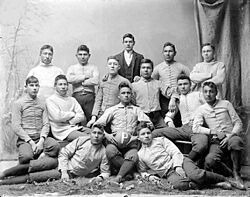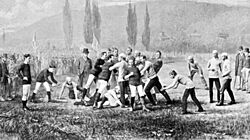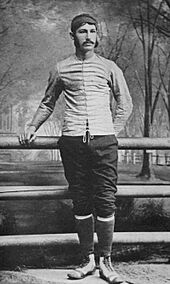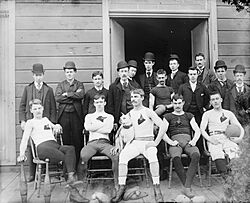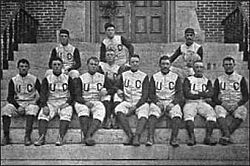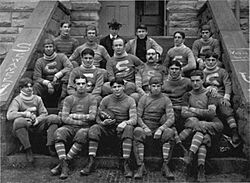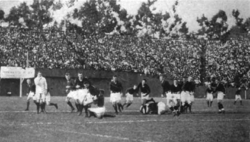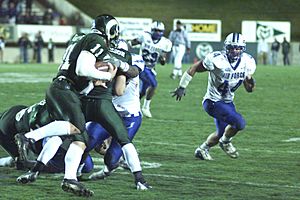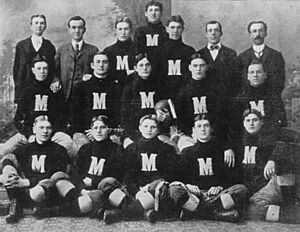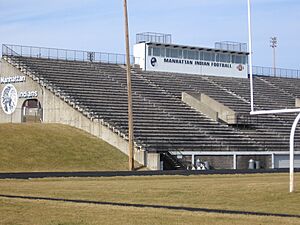History of American football facts for kids
The history of American football began with early versions of rugby football and association football (soccer). Both games came from different kinds of football played in the United Kingdom in the mid-1800s. These older games involved kicking a ball at a goal or over a line, and they were based on even older medieval ball games.
American football changed quite a bit from soccer and rugby. Many of these important rule changes were made by Walter Camp, a player and coach from Yale University. He's often called the "Father of American Football." Some of his big changes included the hike spot (where the ball is snapped), rules about downs and distance, and allowing the forward pass and blocking.
In the late 1800s and early 1900s, college coaches like Eddie Cochems, Amos Alonzo Stagg, and Glenn "Pop" Warner developed new ways to play, especially using the forward pass. College football became very popular and was the main type of football in the U.S. for the first half of the 20th century. Big games called Bowl games drew huge audiences. College football is still very popular today, known for its exciting rivalries and traditions.
The story of professional football started in 1892. That's when Pudge Heffelfinger was paid $500 to play in a game. In 1920, the American Professional Football Association was formed. This league changed its name to the National Football League (NFL) two years later. It eventually became the biggest professional football league. What started as a sport in Midwestern factory towns grew into a national sensation.
The modern era of American football really kicked off after the 1932 NFL Playoff game. This was the first indoor championship game in a long time and introduced new things like hash marks (lines on the field), forward passes from anywhere behind the line, and moving the goalposts back to the goal line. Other new things came soon after, like the first AP Poll for ranking teams in 1934, the first Heisman Trophy in 1935, and the first NFL draft in 1936. The first game shown on TV was in 1939.
American football's huge growth in the second half of the 20th century can be traced to the 1958 NFL Championship Game. This game is often called the "Greatest Game Ever Played." A new league, the American Football League (AFL), started in 1960. The competition between the AFL and NFL led to them merging and creating the Super Bowl. The Super Bowl is now the most-watched TV event in the U.S. every year.
Contents
How Football Began
Early Ball Games
Long ago, in Ancient Greece, people played a game called Episkyros. They tried to throw a ball over a line while avoiding tackles.
Many old forms of football were played across Europe for centuries. These games, sometimes called "mob football," could involve many players from different towns. They would try to drag an inflated pig's bladder (the ball) to markers at each end of a town. Rules were simple, and games could be rough. These old games became less common in the 1800s.
Football in America's Colleges
Modern American football started from these traditional games. Early games in America were often like "mob football." They were not very organized until the 18th century when games started being played within colleges.
In the 1800s, English schools began to create more organized football games. A famous story says that in 1823, William Webb Ellis picked up the ball and ran with it during a school game. This supposedly started a new style of play where running with the ball was important, not just kicking.
Soon, football was played at colleges in the United States. Each school had its own rules. Princeton University students played "ballown" as early as 1820. Harvard had a tradition called "Bloody Monday" in 1827, a big game between freshmen and sophomores. These games were often very rough, leading to injuries. Because of this, some colleges, like Yale, banned football in 1860.
But the game soon returned. By the late 1860s, Yale, Princeton, Rutgers University, and Brown University started playing a "kicking" game. In 1867, Princeton used rules similar to England's The Football Association.
The game between Rutgers and Princeton on November 6, 1869, is usually seen as the first intercollegiate American football game. It was played with a round ball and rules based on early soccer. Two teams of 25 players tried to kick the ball into the opposing goal. Throwing or carrying the ball was not allowed, but there was a lot of physical contact. Rutgers won 6–4. A week later, Princeton won a rematch 8–0 under their own rules.
By 1873, colleges tried to make the rules more standard. Teams were reduced from 25 to 20 players. Scoring was still by kicking the ball through the goal. On October 20, 1873, representatives from Yale, Columbia, Princeton, and Rutgers met in New York City to create the first set of shared rules for college football.
Harvard didn't join this meeting and kept playing its own "Boston game" rules. However, Harvard played McGill University from Montreal in 1874. The second game used rugby rules, which Harvard liked. Rugby had the "try," which later became the touchdown in American football.
On June 4, 1875, Harvard played Tufts University under rules similar to the Harvard-McGill game. Harvard then challenged Yale to play under "Concessionary Rules," which mixed soccer and rugby. On November 13, 1875, Yale and Harvard played for the first time. Harvard won 4–0. A young man named Walter Camp, who would later become the "Father of American Football," watched this game.
Walter Camp: Father of American Football
Walter Camp is the most important person in the history of American football. He was a great athlete at Yale.
Camp thought the game was too messy. In 1878, he suggested reducing the number of players from fifteen to eleven. This rule passed in 1880, making the game more open and faster. Camp's most famous change, creating the line of scrimmage and the snap from the center to the quarterback, also passed in 1880.
These new rules changed the game a lot. Some teams used the scrimmage to slow the game down, keeping the ball for a long time. To fix this, in 1882, Camp proposed the "down-and-distance" rules: a team had to move the ball at least five yards in three downs. These rules, along with the line of scrimmage and the forward pass, turned the game from a rugby variation into the unique sport of American football.
Camp also made other key changes:
- In 1881, the field size was reduced.
- In 1883, he changed the scoring rules: four points for a touchdown, two for kicks after touchdowns, two for safeties, and five for field goals.
- In 1887, game time was set at two 45-minute halves, and two paid officials (a referee and an umpire) were required.
- In 1888, tackling below the waist was allowed.
- In 1889, officials got whistles and stopwatches.
Perhaps the most important change was allowing blocking (also called interference). This was against rugby rules. At first, players would pretend to accidentally block defenders. Walter Camp saw this and, though surprised, soon adopted blocking for his Yale team. Teams developed complex blocking tactics, like the "Flying wedge," which was very effective but later banned in 1894 because it caused too many injuries.
After his playing days, Camp continued to shape football rules and selected an annual All-American team until 1924.
Scoring Changes Over Time
| Time Period | T.D. | F.G. | Con. | Con. (T.D.) | Saf. | Con. (S) |
Def. con. |
|---|---|---|---|---|---|---|---|
| 1883 | 2 | 5 | 4 | – | 1 | – | – |
| 1883–1897 | 4 | 5 | 2 | – | 2 | – | – |
| 1898–1903 | 5 | 5 | 1 | – | 2 | – | – |
| 1904–1908 | 5 | 4 | 1 | – | 2 | – | – |
| 1909–1911 | 5 | 3 | 1 | – | 2 | – | – |
| 1912–1957 | 6 | 3 | 1 | – | 2 | – | – |
| 1958–present | 6 | 3 | 1 | 2 | 2 | 1 | 2 |
Growing the Game (1876–1932)
In 1876, Harvard, Yale, Princeton, and Columbia met to create new rules based on rugby. They formed the Intercollegiate Football Association. A big change was making the touchdown the main way to score, not just a kicked goal.
College football quickly spread across the country. In 1884, Yale beat Dartmouth 113–0, the first time a team scored over 100 points.
The University of Michigan was the first school west of Pennsylvania to have a college football team in 1879. Other Midwestern schools soon followed. The first college football league, the Intercollegiate Conference of Faculty Representatives (later the Big Ten Conference), was founded in 1895.
Football also grew in the South. The first recorded game in the South was in 1880, when Transylvania University beat Centre College. Many famous rivalries started around this time.
In November 1890, college football was first played in Kansas and Tennessee. The first Army–Navy Game was also played that month, with Navy winning.
The first nighttime football game happened in 1892, ending in a 0–0 tie at halftime. In 1893, the first documented use of a football helmet occurred. A player named Joseph M. Reeves wore a leather helmet after his doctor warned him about head injuries.
The Southern Intercollegiate Athletic Association (SIAA) was founded in 1894, bringing together many Southern colleges. The first forward pass in football is thought to have happened in 1895 in a game between Georgia and North Carolina.
The 1899 Sewanee Tigers were a legendary team, going undefeated (12–0) and outscoring opponents 322 to 10. They were known as the "Iron Men" because they had only 13 players and famously won five games in six days on a road trip.
In 1900, Fielding H. Yost became the coach at Stanford University. The next year, he moved to coach the Michigan Wolverines football team. Under Yost, Michigan became a national powerhouse, with a 56-game undefeated streak from 1901 to 1905. This included playing in the first college football bowl game in 1902.
In 1906, some West Coast universities, like California and Stanford, switched from American football to rugby union because they were worried about how violent American football was. They thought rugby would become the national sport. However, East Coast and Midwest teams kept playing American football, and the West Coast schools eventually switched back.
Famous Games
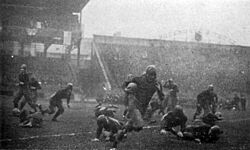
In 1921, Bo McMillin led Centre to upset defending national champion Harvard 6–0. This is considered one of the greatest upsets in college football history. The next year, Vanderbilt played Michigan to a scoreless tie in the first stadium built just for college football in the South.
Modern College Football (1933–Present)
College football continued to grow, especially in the South. By the mid-1920s, teams from the South and West Coast started achieving national success. For example, Wallace William Wade's 1925 Alabama team won the 1926 Rose Bowl, and William Alexander's 1928 Georgia Tech team won the 1929 Rose Bowl. College football quickly became the most popular sport in the South.
New conferences like the Southwest Athletic Conference (1915) and the Southeastern Conference (SEC) (1932) became important. The Big Ten Conference continued to be strong in the 1930s and 1940s.
As college football became more national, new bowl games were created: the Orange Bowl, Sugar Bowl, Sun Bowl, and Cotton Bowl. These games allowed teams from different parts of the country to play each other. In 1936, the Associated Press started its weekly poll to rank college teams. The final AP poll was used to decide the National Champion.
The 1930s also saw the passing game grow. Rules changes in 1934 made the ball easier to throw. Players like Don Hutson and "Slingin" Sammy Baugh became famous for their passing skills.
In 1935, the first Heisman Trophy was given to Jay Berwanger. This award recognizes the nation's "most outstanding" college football player and is one of the most important awards in American sports.
During World War II, many college players joined the military. Some returned to play for teams like Army, which won national titles in 1944 and 1945.
The 1950s saw the rise of powerful teams. Oklahoma, coached by Bud Wilkinson, won three national titles and had a 47-game winning streak. Woody Hayes led Ohio State to two national titles. The 1950s also saw a return to a focus on running plays.
In 1956, Bobby Grier became the first black player to play in the Sugar Bowl, a major game in the Deep South. Despite some objections, his team, the Pittsburgh Panthers, played against the Georgia Tech Yellow Jackets.
Television and Bowl Games
As professional football became popular on TV, so did college football. In 1952, the NCAA controlled all TV rights for college games. This changed in 1984 when the Supreme Court ruled that schools could negotiate their own TV deals. ABC Sports started broadcasting a national "Game of the Week" in 1966, bringing big games to a national audience.
New ways of playing, like the wishbone offense (a run-heavy offense) and the spread offense (often a passing offense), were developed.
The number of bowl games grew a lot. In 1940, there were only five bowl games. By 2020, there were 40! This growth has been debated, with some saying it makes bowl games less special, and others saying it helps more schools get exposure and money.
With so many bowl games, it became hard to pick a true national champion. To fix this, systems like the Bowl Coalition (1992) and the Bowl Alliance (1995) were created to try and match up the top teams.
Bowl Championship Series
In 1998, the Bowl Championship Series (BCS) was created. It included all major conferences and four big bowl games (Rose, Orange, Sugar, and Fiesta). The top two teams in a complex ranking system played for the national championship. This system aimed to create a clear national champion.
College Football Playoff
Because the BCS sometimes had controversial results, a new system called the College Football Playoff started in 2014. Four teams play in two semifinal games, and the winners play in the National Championship game. This system has been dominated by teams like Alabama and Clemson.
Professional Football: From Local to National
Early Professional Teams (1892–1919)
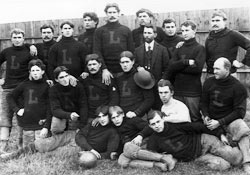
In the early 1900s, football became very popular locally. In 1892, Pudge Heffelfinger became the first known professional football player when he was paid $500 to play for the Allegheny Athletic Association.
On September 3, 1895, the first fully professional game was played in Latrobe, Pennsylvania. Latrobe won 12–0. Latrobe's quarterback, John Brallier, was the first player to openly say he was paid to play. In 1897, the Latrobe Athletic Association became the first team to pay all its players for the whole season.
The Morgan Athletic Club was founded around this time. This team later became the Arizona Cardinals, making them the oldest continuously playing professional football team.
The first known professional football league, also called the National Football League (but not the same as today's NFL), started in 1902. It included teams formed by baseball clubs. The first indoor pro football games were played in a tournament called the World Series of Football.
Professional football also grew in Ohio. Small towns like Massillon and Canton had professional teams in a group called the "Ohio League." This league was a direct ancestor of today's NFL. In 1906, the Canton Bulldogs–Massillon Tigers betting scandal was the first major scandal in pro football, involving attempts to fix a game.
In 1915, the Canton Bulldogs signed famous Olympian Jim Thorpe. Thorpe became the face of professional football and was there when the modern NFL was founded five years later.
The NFL's Early Years (1920–1932)
Forming the League
In 1920, the American Professional Football Association (APFA) was founded in Canton, Ohio. Jim Thorpe was chosen as the league's first president.
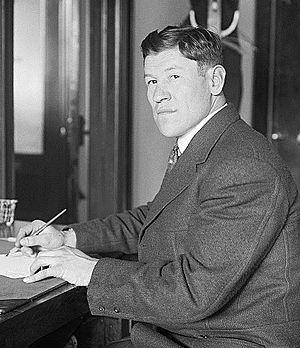
Some of the original teams included:
- Akron Pros
- Canton Bulldogs
- Decatur Staleys
- Green Bay Packers (joined in 1921, now the longest-running team name)
In its early years, the league was a loose agreement. Teams could still play non-league teams. Only four teams finished the first season, and Akron claimed the first championship.
The APFA became the National Football League (NFL) in 1922. In 1921, George Halas bought the Decatur Staleys, moved them to Chicago, and renamed them the Chicago Bears.
Expansion and Growth
By the mid-1920s, the NFL had grown to 25 teams. College stars like Red Grange joined the NFL, helping it become more popular.
The 1932 Playoff Game
At the end of the 1932 season, the Chicago Bears and Portsmouth Spartans were tied. To decide the champion, the league held its first playoff game. It was played indoors due to cold weather, which led to some temporary rule changes. Chicago won 9–0. This game was so popular that the league reorganized into two divisions for the 1933 season, with a championship game planned at the end. New rules were also added, like moving the goalposts forward and allowing forward passes from anywhere behind the line of scrimmage. In 1936, the NFL started its first draft of college players.
NFL Stability and Growth (1933–1969)
The 1930s were a time of big changes for the NFL. New teams like the Pittsburgh Steelers and Philadelphia Eagles were founded in 1933. In 1941, the NFL named its first Commissioner, Elmer Layden.
During World War II, many players joined the military. This led to some teams merging for a short time, like the Steagles (Pittsburgh and Philadelphia) in 1943.
In 1946, the league became reintegrated, meaning African American players were allowed to play again. The Los Angeles Rams signed Kenny Washington and Woody Strode. Also in 1946, a competing league, the All-America Football Conference (AAFC), started.
In 1950, the AAFC folded, and three of its teams, including the Cleveland Browns, joined the NFL. The Los Angeles Rams became the first team to show all its games on TV, starting a very important relationship between TV and professional football. The players' union, the NFL Players Association, formed in 1956.
The Greatest Game Ever Played
At the end of the 1958 NFL season, the Baltimore Colts and the New York Giants played for the championship. The game was tied after 60 minutes and went into sudden death overtime for the first time in an NFL game. The Colts won 23–17. This game, known as "the Greatest Game Ever Played," was shown live on TV and helped make the NFL super popular across the United States.
The AFL and NFL Merger
In 1959, Lamar Hunt led the creation of the rival American Football League (AFL). Unlike earlier leagues, the AFL was a serious challenge to the NFL, especially with TV exposure. The AFL tried to sign top college players, even those from smaller colleges or historically black colleges.
The AFL became a strong league. In 1966, the two leagues agreed to a partial merger. They decided to have a common draft and play a championship game at the end of the season, called the AFL-NFL World Championship. Two years later, this game was renamed the Super Bowl.
AFL teams won the next two Super Bowls. In 1970, the two leagues fully merged to form a new 26-team league. The new NFL adopted some of the AFL's ideas, like putting names on player jerseys, official scoreboard clocks, national TV contracts (like Monday Night Football), and sharing money from ticket sales and TV rights.
Modern NFL (1970–Present)
The NFL continued to grow, adding new teams to reach its current 32-team size. The Super Bowl has become a huge cultural event in the U.S., bringing in a lot of money from advertising. The NFL is now the most popular spectator sports league in the United States.
One thing that makes the modern NFL special is how balanced the teams are. Even though some teams are dominant for a while, most teams feel like they have a chance to win the championship each year. This is partly due to the league's rules with its players' union, which includes a salary cap (a limit on how much teams can spend on player salaries) and sharing revenue between teams. This helps prevent the richest teams from getting all the best players.
Other Professional Leagues
Several other professional football leagues have been formed since the AFL–NFL merger, but none have been as successful as the NFL.
- The World Football League (WFL) formed in 1974 but folded after two seasons.
- The original United States Football League (USFL) started in 1983 as a spring league. It had some success but folded after trying to compete directly with the NFL in the fall. A new version of the USFL started in 2022.
- The NFL also created a developmental league called the World League of American Football (WLAF), which later became NFL Europe, playing in Europe until 2007.
- The original XFL was formed in 2001 but lasted only one season. A new XFL began play in 2020 and returned in 2023.
Youth and High School Football
Football is a very popular sport for young people. One of the earliest youth football groups, the Junior Football Conference, started in Philadelphia in 1929. It was renamed the Pop Warner Conference in honor of coach Pop Warner.
Today, Pop Warner Little Scholars has over 300,000 young boys and girls aged 5–16 playing football and cheerleading. Other groups like the Police Athletic League and the NFL's Youth Football Program also run youth leagues.
Football is also very popular in high schools across the U.S. More than 13,000 high schools have football teams. Some high school stadiums are so big they look like college facilities! The growth of high school football and its importance in small towns has been shown in books and TV shows like Friday Night Lights.
American Football Around the World
American football has been played outside the U.S. since the 1920s. Its popularity grew after World War II, especially in countries where many U.S. military members were stationed.
In 1998, the International Federation of American Football (IFAF) was formed to help organize amateur competitions around the world. The IFAF organizes the World Championship of American Football every four years.
A big goal for the IFAF is to have American football accepted as an Olympic sport. The only time it was played in the Olympics was in 1932 in Los Angeles, but only as a demonstration sport (meaning it wasn't an official medal event).
Similar Football Games
Other types of football share a history with American football:
- Canadian football developed alongside American football. They are similar but have some important differences.
- Arena football is a newer sport based on American football, designed to be played indoors. The Arena Football League was founded in 1987.
- Rugby continued to evolve into two main types: rugby union and rugby league. Both have adopted some ideas similar to American football.
- Australian rules football, also called "Aussie rules," was first played in 1858. It's played on an oval field with 18 players.
- Gaelic football is an Irish sport with a round ball. Players can carry, bounce, kick, or hand-pass the ball. It was formally organized in 1885.
Images for kids


